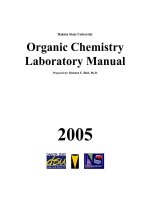General chemistry laboratory report
Bạn đang xem bản rút gọn của tài liệu. Xem và tải ngay bản đầy đủ của tài liệu tại đây (977.58 KB, 13 trang )
<span class="text_page_counter">Trang 1</span><div class="page_container" data-page="1">
VIET NAM NATIONAL UNIVERSITY HO CHI MINH CITY
</div><span class="text_page_counter">Trang 2</span><div class="page_container" data-page="2"><b>Unit 2: Heat of reactionI. Introduction</b>
Determine heat reaction, confirm Hess’s law
Hess's law states that the enthalpy or heat change accompanying a chemical process depends only on the initial and final states and is independent of the pathway. Principle of calculation: in non – phase change process
<i> (cal/mol)</i>
Calorimeter: well insulated container equipped with stir rod and thermometer.
<b>II. Practice:</b>
1/ With calorimeter:
Determining heat capacity of calorimeter
- Place 50 ml at room temperature to beaker, measure temperature - Place 50 ml at about 60 C to calorimeter, wait for the temperature stable, <small>o</small>
read temperature . Keep thermometer inside the calorimeter.
- Using funnel, quickly transfer the water from beaker to calorimeter. Cap, wait for the temperature stable, read the temperature
- Determine of the clorimeter from the heat balance equation
In which, m: mass of 50 ml water
c: heat capacity of water (1cal/g.K) 2/ Neutralization reaction between HCl and NaOH
- Prepare burette containing NaOH 1M. In preparation step, measure the temperature of NaOH. After measurement, rinse the thermometer. - Prepare burette containing HCl 1M and transfer 25 ml HCl 1M to
calorimeter, measure the temperature . Keep thermometer inside calorimeter. - From burette containing NaOH 1M, transfer 25 ml to calorimeter. Cap and
mix the solution, measure the temperature . - Canculate the heat quantity Q và ΔHr
Assume heat capacity of diluted solution is 1cal/g.K. Specific weight of salt solution is 1.02 g/ml
</div><span class="text_page_counter">Trang 3</span><div class="page_container" data-page="3">3/ Heat of dissolution of anhydrous (copper (II) sulfate)
- Place into calorimeter 50 ml water. Measure the temperature t1 - Weight exactly about 4 g anhydrous .
- Quickly transfer to the calorimeter, stir to dissolve completely, measure the temperature t2
- Determine the heat Q and ΔH solution. Confirm Hess’s law. Heat capacity of CuSO4 varies with temperature (K)
We choose Cp at average temperature 4/ Heat of dissolution of
- Similar to previous section 3, replace by Note: How to determine the temperature after the reaction
- Measure the temperature before the reaction
- Place reactant into the calorimeter, measure the temperature each 30s. - Draw the graph of temperature versus time
- Determine Δt using graph as the following figure. It is the maximum
</div><span class="text_page_counter">Trang 4</span><div class="page_container" data-page="4">Experimental report of unit 2
<b>Experiments are conducted three times, if the results of two times are similar, the third time is not necessary.</b>
</div><span class="text_page_counter">Trang 5</span><div class="page_container" data-page="5">(Detail calculation of one value of Q and ΔH)
II. Answer the questions
1. ΔH of the reaction HCl + NaOH NaCl + H2O is calculated based on the molar of HCl or NaOH when 25 ml of HCl 2M solution react with 25ml of NaOH 1M solution? Explain. Answer:
NaOH completely reacts. The reaction is calculated based on the molar of NaOH
2. If replace HCl 1M by 1M, the result of experiment 2 will change or not?
Does not change because HCl and are both strong acids, completely dissociate and this is a neutralization reaction.
<small>5</small>
</div><span class="text_page_counter">Trang 6</span><div class="page_container" data-page="6">3. Calculate base on Hess’s law. Compare to experimental result. Considering 6 reasons that might cause the error - Heat loss due to the calorimeter
- Thermometer - Volumetric glassware - Balance
- Copper (II) sulfate absorbs water
- Assume specific heat of copper (II) sulfate is 1 cal/mol.K In your opinion, which one is the most significant? Explain? Is there any other reason?
-According to Hess’ law: -In practice:
The difference is too big
-In my opinion, the heat loss due to the calorimeter is the most important, due to the incorrect operation, which quickly leads to heat loss to the outside.
- Anhydrous copper sulfate is hygroscopic, taking and weighing is not fast and careful, it is easy to make absorb moisture quickly, affecting the thermal effect of
</div><span class="text_page_counter">Trang 7</span><div class="page_container" data-page="7">Unit 4: Reaction rate I. Introduction
1. Law of mass action
In which: k – rate constant, constant at defined temperature n – reaction order with respect to A, m – reaction order with respect to B
m+n – overall order of the reaction For simple reaction: exponent equals to stoichiometric coefficient
For complicated reaction: the exponent are generally not relate to stoichiometric
coefficient. It can be non-integer or negative. 2. Initial rate method:
Keep constant ΔC (same turbidity, color, …), keep initial concentration of all reagents constant except one. Vary concentration of one reactant, we can determine the order with respect to the varied concentration species.
Method 1: obtained from the double initial concentration expression
Calculate m and get the average Method 2: using linear regression
Linear regression to obtain m II. Practice:
1. Determining reaction order with respect to
Prepare three test tubes containing and three conical flask containing and as the following table
</div><span class="text_page_counter">Trang 8</span><div class="page_container" data-page="8">Experimental report of unit 4
From of experiment 1 and 2, determine (sample calculation)
Reaction order with respect to 2. Reaction order with respect to
From of experiment 1 and 2, determine (sample calculation)
Reaction order with respect to
II. Answer the questions:
1. In the experiment above, what is the effect of the concentrations of and on the reaction rate? Rewrite the reaction rate expression. Determine the order of the reaction. Answer:
The concentration of Na2S2O3 is proportional to the reaction rate, the concentration of H2SO4 has almost no effect on the
</div><span class="text_page_counter">Trang 9</span><div class="page_container" data-page="9">Base on the experimental results, may we conclude that the reaction (1) or (2) is the rate-determining step, which is the slowest step of the reaction? Recall that in the experiments, the amount of the acid is always used in excess.
- (1) is an ion exchange reaction, so the reaction rate is very fast.
- (2) is a self-oxidation reaction, so the reaction rate is very slow. Reaction (2) is the rate-determining reaction.
3. Base on the principle of experimental method, the reaction rate is considered as instantaneous rate or average rate. Answer:
Velocity is determined by ΔC/Δt because ΔC~0 (the change in concentration of sulfur is negligible over the time period Δt ) so the velocity in the above experiments is considered as instantaneous velocity.
4. Reverse the order of adding and , does the reaction order change? Explain?
Changing the order for and , the order of the reaction does not change. At a given temperature the order of reaction depends only on the nature of the system (concentration, temperature, surface area, pressure) and not on the order of reactants.
<small>9</small>
</div><span class="text_page_counter">Trang 10</span><div class="page_container" data-page="10"><b>Uni 8: Volumetric analysis</b>
<b>Introduction </b>
Volumetric analysis is the method to quantitative determination of species X based on measurement of the volume. Volumetric analysis is often referred to as titration, a technique in which typically the exact volume of unknown concentration of component X (measured by pipette and placed into conical flask) is reacted with the standard solution. The standard solution which the concentration is accurately known is usually added gradually to the flask from a burette.
The standard solution is called the titrant; the solution being analyzed is called the analyte.
Delivery of the titrant until the process is judged to be complete is called a titration.
The reaction C+X A+B is called titration reaction. The principle of calculation: law of equivalent proportion
The point at which complete chemical reaction takes place and equivalent quantity of
reagent is used is called equivalence point:
The equivalence point can only be estimated by observing a physical change such as color change, turbidity. The point in titration when this physical change occurs is called end point.
Indicators are usually added to the analyte to give a signal of the end point.
A titration curve is a plot typically showing the changes of logarithm of the concentration of the titrated solution versus the volume of the added standard
The requirement for the indicator is the end point within the titration jump. The shape of titration curve depends on the concentration, equilibrium constant of titration reaction.
Note that the equivalence point will have the pH corresponding to the pH of the salt solution. In case the salt forms when neutralize the strong acid by strong basic (for example HCl and NaOH), the pH at the equivalence point is 7, while neutralize the strong acid by the weak base or weak acid by a strong base, the pH at the equivalence point will differ from 7. The following table shows the transition range of some common indicators.
</div><span class="text_page_counter">Trang 11</span><div class="page_container" data-page="11">Indicator <sup>Color</sup>
acid form <sup>pH range of</sup><sub>transition</sub> basic form
<b>II. Practice</b>
1/ Constructing the titration curve
Construct the titration curve of the titration of a strong acid by a strong base
Rinse burette by NaOH 0.1N, and then pour NaOH to the burette. Adjust the liquid level to zero.
Use pipette to measure 10 ml HCl solution which the concentration is unknown and transfer to Erlenmeyer flask 150 ml. Add 10 ml distilled water and two drops of phenolphthalein.
Open the stopcock to drop slowly NaOH solution to Erlenmeyer flask. Swirl the flask while dropping. Until the solution in the flask changes to faith-pink, close the stopcock. Read the consumed volume of NaOH.
Repeat the experiment one more time. 3/ Experiment 3
Do similar to experiment 2, but replace the phenolphthalein indicator by methyl orange. The color of the solution changes from red to orange.
4/ Experiment 4
Do similar to experiment 2, but replace the HCl solution by acid acetic solution. Repeat two times, first time using phenolphthalein, the later using methyl orange.
<small>11</small>
</div><span class="text_page_counter">Trang 12</span><div class="page_container" data-page="12">Experimental report of unit 8
Approriate indicator: phenolphthalein.
2. Experiment 2: Titration of HCl by Phenolphthalein
</div><span class="text_page_counter">Trang 13</span><div class="page_container" data-page="13">NaOH 0.1N 1.0 0.90 0.85
<b>II. Answer the questions</b>
1. When changing the concentration of HCl or NaOH, does the titration curve change? Explain.
When changing the concentration of HCl and NaOH, the titration curve does not change because the HCl titration method with NaOH is determined based on the equation:
HCl + NaOH NaCl + =
- With and does not change, so when increases or decreases, also increases or decreases. From this we deduce, whether expanding or contracting, the titration curve remains the same.
<b>- Similarly for the case of changing NaOH concentration.</b>
2. The determination of the concentration of HCl in experiment 2 and 3, which one is more precise.
Determination of HCl acid concentration in experiment 2 gives more accurate results. Because phenolphthalein helps us to identify colors more accurately, more clearly, because the color change from colorless to pale pink is more noticeable from red to orange.
3. From the result of experiment 4, for the determining concentration of acid acetic solution, which indicator is more precise?
Phenol phthalein is more accurate than methyl orange because acetic acid is a weak acid so the titration point is greater than 7 so using phenol phtalein is more accurate than methyl orange (the 3.0 – 4.4 hop is too far).
4. In volumetric titration, if NaOH and HCl are interchanged, does the result change? Explain?
No change as this is an equilibrium reaction.
<small>13</small>
</div>








